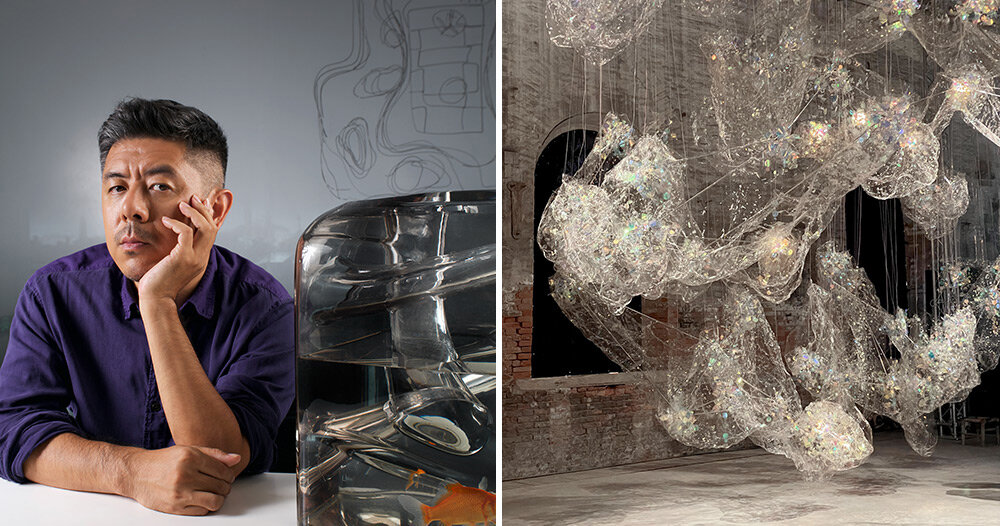china pavilion opens in venice with ‘co-exist’ exhibition
With curation by MAD founder Ma Yansong, the China Pavilion at the Venice Architecture Biennale opens with a quiet invitation to step into a layered dialogue. Here in the Arsenale, the architect has gathered ten works by twelve teams, mostly from China’s emerging generation of architects. Their contributions form a dense landscape of research and imagination, offering a portrait of China’s past and future together in conversation.
The China Pavilion in Venice does not frame nature as scenery or resource. It unfolds as a landscape where human emotion and the natural world blur into one another, a notion that Ma refers to as ‘tian ren he yi,’ the unity of nature and humanity. He reflects on this value often overlooked in the modern city. ‘We have better technology now, but so what? Historic buildings are still great,’ he tells designboom during an interview at the pavilion’s opening in Venice. ‘In China we build so many high-rises. But people want to live in gardens. So after all this development, why aren’t we building something that’s more ideal?‘
MAD founder Ma Yansong, image courtesy MAD
ma yansong proposes an architecture of feeling
At the 2025 Venice Architecture Biennale, the China Pavilion expands MAD founder Ma Yansong’s reflections toward the architecture of tomorrow. Models and installations throughout the exhibition suggest ways to transform unloved urban environments into places of community and life. designboom spoke with the architect in front of a sprawling city model built from discarded architectural fragments. He explained how this imagined city begins as a landscape of waste, only to be reshaped through interventions designed to restore livability. ‘A second layer of ‘plug-in architecture’ is added,’ he explains. ‘So theoretically, the team can transform a city that is not so ideal, into something liveable.’ One screen even streams Chinese social media users describing their ideal city, turning personal reflections into design feedback.
The pavilion reveals MAD’s commitment to keeping architecture rooted in the emotional lives of people. Ma describes a shift from the mechanical ambitions of past urbanization toward something more human and perceptive. ‘In the intelligent future, the feeling you get when you enter a space will matter most,’ he says. Across the pavilion, works explore how recycled materials, shared memory, and collective participation might reshape the future city. Through these experiments, the exhibit proposes that architecture is not defined by its height or complexity, but by its ability to gather people together, and to move them. Read designboom’s full interview with Ma Yansong below!
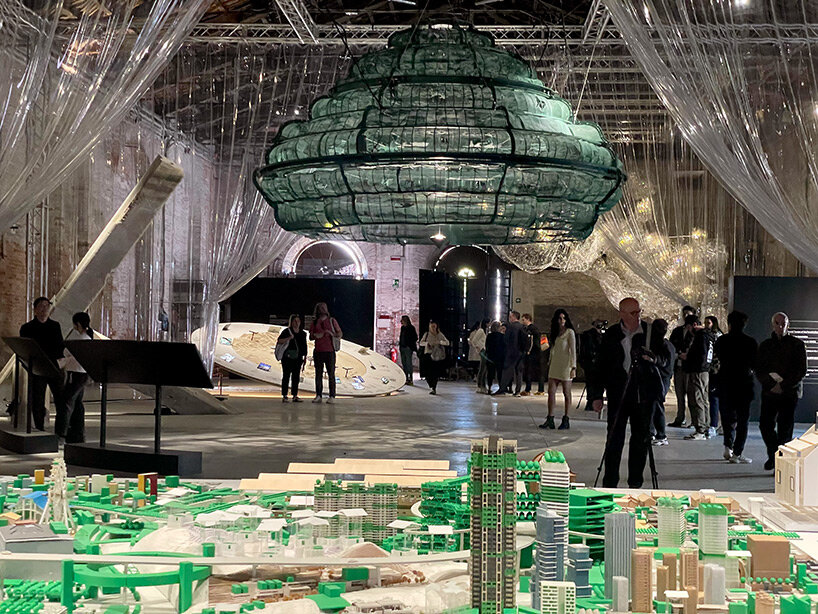
CO-EXIST, installation image by designboom
dialogue with ma yansong
designboom (DB): Can you explain your theme and curation?
Ma Yansong (MY): The theme is CO-EXIST, talking about the how to combine all different ideas together. When we talk about China, of course we talk about the past, because we have a lot of tradition. But we also talk about the future. We talk about technology, but we also talk about human emotion. We talk about a lot of cities in China, but also nature. These dualities are rich discussions among all these works.
The show exhibits ten projects, each one addressing different issues. Through these works, you will see the real China. Combining all of them together, we want to show that China is a huge and diverse place. You can see many things at the same time, and they have to coexist. When these themes are displayed together here in Venice, you can see the difference between Eastern culture and Western culture, and the possibility for dialogue and coexistence between these different values.

CO-EXIST, installation image by designboom
DB: Can you describe ‘tian ren he yi,’ the Chinese idea about the harmony between nature and humans?
MY: When I see all these works, a lot of them talk about nature. I found this phrase in our traditional culture that in architecture, also in other art forms, people consider nature not just a resource, but a spiritual extension of human beings. When you see a tree or rock, it becomes part of your emotion. Everything around us in nature becomes part of the human. It becomes narrative and imagination. That is totally lacking in the modern world.
We often talk about nature to the extent that a city needs a park or a tree, but it’s something more. We’re discussing the possibility to bring this tradition to the future. When we talk about intelligence, it’s not just about technology, nor is it about our behavior. It’s about emotions. A lot of people are inspired by history, where nature is a central value.
‘Tian ren he yi’ literally means ‘sky and human become one thing combined.’ If you visit a building, you feel something. Everyone can feel something. They love it, or they feel moved. Light tells story. It’s hard to describe. In the intelligent world of the future, the human reception, how people feel, is so important. Artificial intelligence be used to further this human reception. But in the past, urbanization focused too much on technology — the material, the tectonics, the height, the structure. It’s too far from what you feel. I think that emotional aspect will be central to architecture in the future.
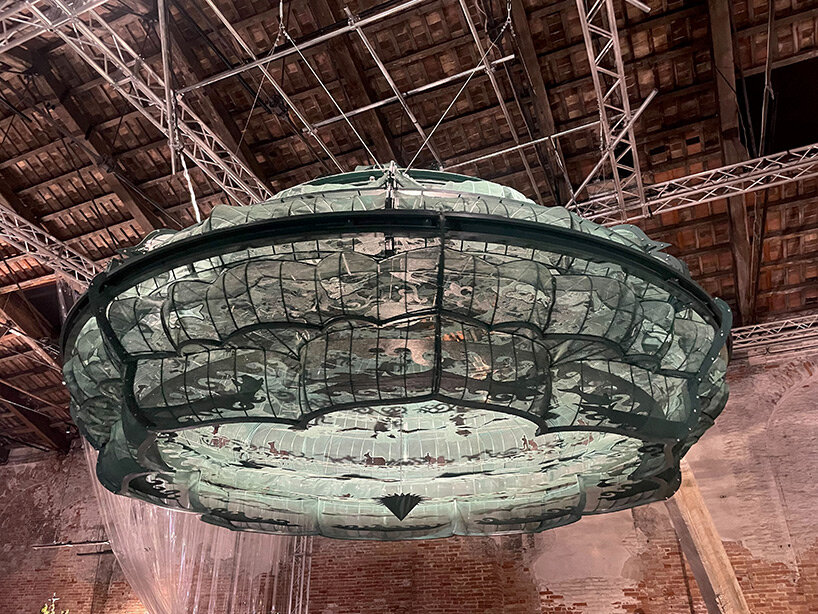
CO-EXIST, installation image by designboom
DB: How has your practice evolved when it comes to exploring the future, and reconciling futuristic visions with local identity and culture?
MY: We are thinking about new technology. This includes artificial intelligence, obviously, but beyond that, we are responding to what’s emotional. How architecture and the built environment can link to humans’ emotion. That’s also intelligence. It doesn’t really link to the latest technology. You can find that through historical buildings, that’s the reason we keep them, and why we’re inspired from them. We have better technology now, but so what? They’re still great. In China we build so many high-rises. But people want to live in gardens. So after all this development, why aren’t we building something that’s more ideal?
Architecture is about emotion and narratives. It’s about community. People won’t like something that has nothing to do with people. That doesn’t mean it can’t be new — it can be something really new, but it should tell a story about some core values. If you look at older, traditional architecture, it’s all about how people live and love, their family and friends, how they gather, and how they understand other people. New architecture should do the same. Maybe in different ways, but it should bring people together and build community.
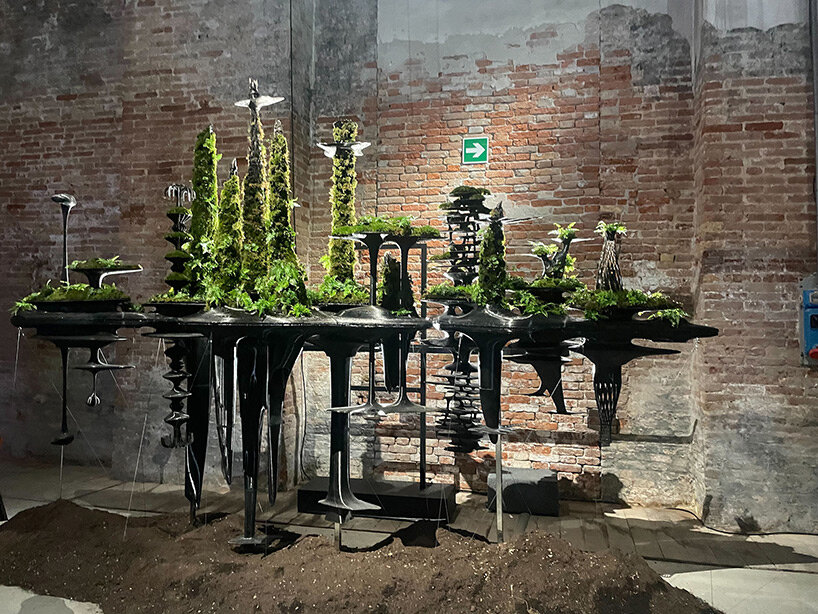
CO-EXIST, installation image by designboom
DB: Can you describe how a few of the specific works capture these ideas that you’re calling for?
MY: The pavilion’s curation began with a light installation. We have three sections. The first one is inspired from the historical work. The light installation is inspired by the desert caves of Dunhuang, a UNESCO site. That was on the Silk Road. People drew the a map of the stars on the wall of a cave. Over time, different civilizations would go there and draw a different star map. But the stars there are the same. People didn’t use the art to express different understandings, or tell different stories.
Another example shows that the story of nature means different things to different cultures, and these cultures can coexist together. A project in the center of the pavilion questions how we look at cities of the future. The team proposes a way to recycle and reassemble concrete. We build so many concrete buildings. What we do with them? They can be disassembled and resembled to become a new structure.
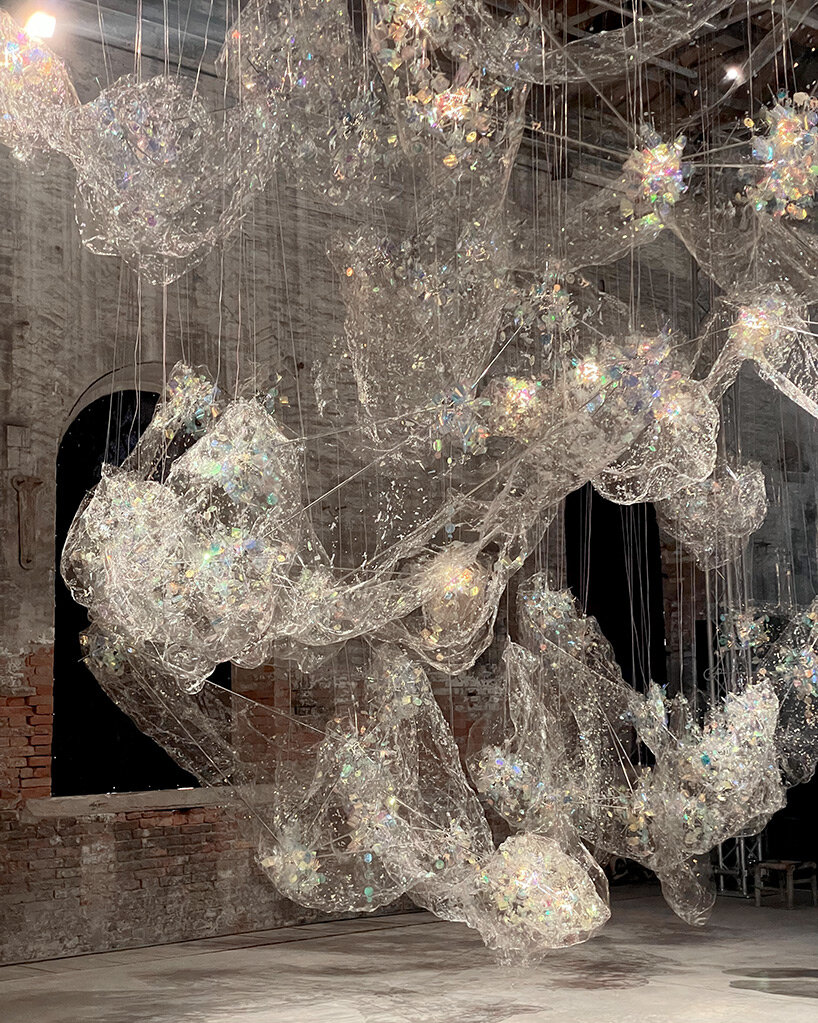
CO-EXIST, installation image by designboom
MY (continued): At the far end of the pavilion is a large model of small buildings. That city is a random city. They collected wasted models and put them together to become a city that is not so livable. And then they attach another layer as an insert that they call a ‘plug-in architecture,’ to make it livable. So theoretically, they can transform a city that is not so ideal, into something liveable.
The exhibit is backdropped by a screen. It’s actually from a large social media in China. It shows people talking about their own city and their ideal life. Then their feedback will go back to the designers, who will then design something from the bottom up. It shows how social media can change the way cities can form. So the designers took the ideas and presented them in their model.

